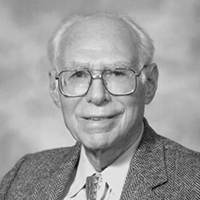John R. Pierce
Pierce was influential in the development of microwaves and radar during WW II, then began working on the theory of satellite communication in 1954. His writings, which detailed the use of satellites in beaming radio signals around the world, were largely ignored. However, he convinced NASA to convert the Echo balloon satellite into a radio wave reflector. His successful experiments with Echo in 1960 led to the development of Telstar, which initiated modern television and radio communications by amplifying signals from one station on Earth and beaming them to another.
Pierce attended the California Institute of Technology , Pasadena, receiving his Ph.D. in electrical engineering in 1936. That year he began working for Bell Telephone Laboratories, Inc., New York City. He improved the traveling-wave tube, which is used as a broadband amplifier of microwaves, and designed a new electrostatically focused electron-multiplier tube, used as a sensitive radiation detector. His Pierce electron gun produces high-density electron beams. During World War II he collaborated on the low-voltage reflex klystron oscillator that was almost universally used in U.S. radar receivers. In 1948 Pierce coined the term transistor to describe the new solid-state device invented at Bell Laboratories.

John R. Pierce
Date of Birth: 27 Mar 1910
Birth Place: Des Moines, Iowa, United States
Proffession: American Engieer
Nationality: United states
Death: 2 April 2002, Sunnyvale, California, United States


